Home > Article > Web Front-end > JavaScript reading and writing cookies example tutorial
This article mainly introduces the relevant knowledge points of JavaScript reading and writing cookies through examples. Friends who are in need of this can refer to it. I hope it can help everyone.
First of all, let us briefly understand cookies.
In the process of making web pages, we often need to transfer information from one page to another. At this time, we need to The cookie mechanism in JavaScript is used. Simply put, cookies provide a convenient way to save small amounts of data on the user's computer and obtain it remotely, allowing websites to save details such as the user's habit settings or the time of the last visit to the website. The cookie itself is a short piece of information that can be saved on the user's computer by the page and then read by other pages. Cookies are generally set to expire after a certain period of time.
Of course, cookies also have limitations: browsers have limits on the number of cookies that can be saved, usually a few hundred or more. Under normal circumstances, 20 cookies are allowed per domain name, and each domain can save up to 4KB of cookies. In addition to the problems that may be caused by size restrictions, there are also many reasons that may cause cookies on the hard disk to disappear, such as reaching the expiration date. Or the user cleared the cookie information, or switched to another browser. Therefore, cookies are not suitable for storing important data. When writing code, you must also consider how to handle cookie acquisition exceptions.
In JavaScript, use the cookie attribute of the document object to store and obtain cookies. Usually, the information in document.cookie is a string consisting of pairs of names and values. The form of each pair of data is :
name=value;
Below we will use a simple example to show how to read and write cookies in JavaScript.
The first is createCookie.html, A cookie will be created in this page. The complete code is as follows:
createCookie Userame:
Password:
The screenshot of the page is as follows:
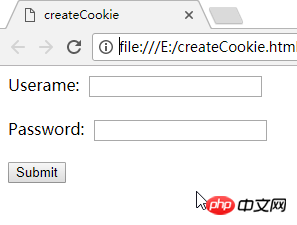
Click the submit button, a cookie will be created, the Username and Password information will be saved in the cookie, and it will jump to the showCookie.html page. Among them, the complete code of the showCookie.html page is as follows:
showCookie
The screenshot of the page is as follows:
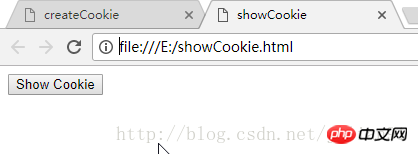
Click the show Cookie button The information in the cookie will be displayed.
Next, we will run this program locally and on the server, and run this program on IE browser and Chrome browser respectively to see the operation of cookies.
First we run this program locally, and we put the above two files on the E drive. First run it on the IE browser, enter the information on the createCookie.html page, and click the submit button. The screenshot is as follows:

After jumping to the showCookie.html page, click show Cookie button, the page screenshot is as follows:

Cookies run normally in the IE browser in the local environment.
Next, let’s take a look at the operation in the Chrome browser. First, open the createCookie.html page in the Chrome browser, enter the information, and click the submit button. The screenshot is as follows:
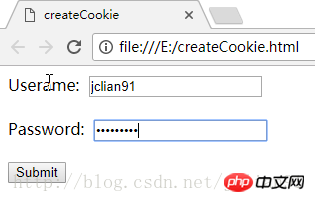
After jumping to the showCookie.html page, click the show Cookie button. The page screenshot is as follows:
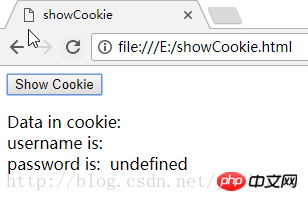
Same procedure, this time the cookie is in Chrome It failed to run in the browser.
Then let us run this program in the server. We need to use xampp, open the Apache server, and place the above two html files in the htdocs folder under the xampp installation folder (the specific operation method can be Refer to this blog: Using AJAX with JavaScript (for beginners)). We now run the program in the IE browser, enter the URL in the IE browser: http://localhost/createCookie...:

Click the Submit button to jump Go to the showCookie.html page and click the show Cookie button. The screenshot is as follows:
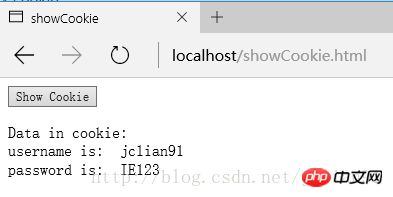
Then we enter the URL in the Chrome browser: http://localhost/createCookie... :
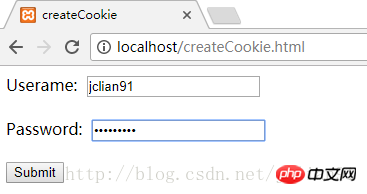 ##
##
Click the Submit button, jump to the showCookie.html page, and click the show Cookie button. The screenshot is as follows:
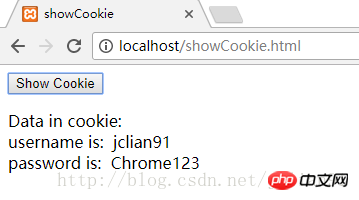
This time in the server environment, IE browser and Chrome browser cookies are working fine!
Related recommendations:
JavaScript implementation method of reading and writing cookies
jQuery implements replacement by writing cookies Web page background method_jquery
Write cookie JavaScript code library cookieLibrary.js_javascript skills
The above is the detailed content of JavaScript reading and writing cookies example tutorial. For more information, please follow other related articles on the PHP Chinese website!